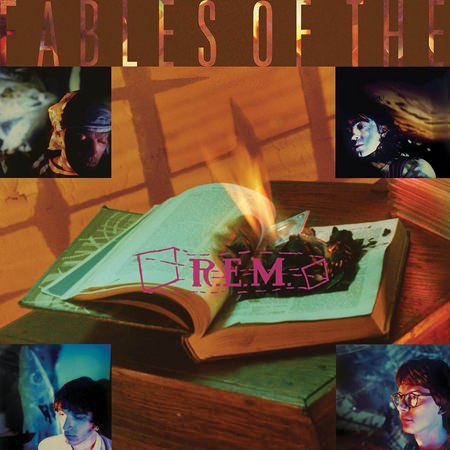
R.E.M. – Fables of the Rescontruction/Reconstruction of the Fables (I.R.S.)
This album caught me completely off balance. I was actually moved to tears when the closing track unfolded in the dimly lit and silent room where I had been sitting motionless and spellbound for the last 35 minutes, listening to the album’s ten magical, bewitchingly mysterious songs.
Michael Stipe’s surreal singing in tongues, the splash of electric colours, the rocky shuffle that hits you like a whip, the soft and hazy melody lines soothing your brow, all the tiny details that hovered like fairies dancing across the moors in the dying daylight, the distant, obsessed moans of the choruses sounding as if coming from a parallel world.
I was gatecrashing a seance, I was mesmerized. And then “Wendell Gee” slowly unfolded, tender, gentle, the chorus a caress of beauty and infinite longing. There were tears in my eyes and I was filled with an inexpressible gratitude to R.E.M. for sharing this with me, yes, I was euphoric, for did they not share it with all mankind?
It’s a great album made even better by placing “Wendell Gee” as the last number. This way R.E.M. achieves something very rare: The perfect ending. Redemption. Catharsis. The last piece of the puzzle elevates the listening experience, it creates the illusion that every preceding trak points to these three sacred minutes. A masterstroke, the hand of God.
“Fables of the Reconstruction” belongs to an exclusive club of classic albums that are unthinkable without their concluding track. As “Ziggy Stardust” concludes with “Rock’n’Roll Suicide”, as “Sgt. Pepper” concludes with “A Day In The Life”, as “Highway 61 Revisited” concludes with “Desolation Row”. But none of these have literally moved me to tears like “REM” did with “Fables Of The Reconstruction”. The Norwegian author Jens Bjørneboe once did when I read the epilogue of “Drømmen og hjulet” (The Dream and the wheel), the story of female writer Ragnhild Jølsen. Some movies have done it too. But those are rare moments. One should certainly appreciate them.
Every time I hear “Wendell Gee” I feel grateful. Now I have played it again. Thank you, R.E.M.
Released: June 1985
(All songs written by Bill Berry, Peter Buck, Mike Mills and Michael Stipe except as indicated.)
Side One – “A Side”
1.”Feeling Gravitys Pull” – 4:51
2.”Maps and Legends” – 3:10
3.”Driver 8″ – 3:23
4.”Life and How to Live It” – 4:06
5.”Old Man Kensey” (Jerry Ayers, Berry, Buck, Mills, and Stipe) – 4:08
Side Two – “Another Side”
1.”Cant Get There from Here” – 3:39
2.”Green Grow the Rushes” – 3:46
3.”Kohoutek” – 3:18
4.”Auctioneer (Another Engine)” – 2:44
5.”Good Advices” – 3:30
6.”Wendell Gee” – 3:01
R.E.M.
Michael Stipe – lead vocals (credited as “JM Stipe – Gaffer Interpreter”)
Mike Mills – bass guitar, piano, vocals (credited as “ME Mills – Consolate Mediator”)
Peter Buck – guitar, banjo, harmonica (credited as “PL Buck – Ministry of Music”)
Bill Berry – drums, vocals (credited as “WT Berry – Best Boy”)
Additional Musicians
David Bitelli – tenor and baritone saxophone on “Cant Get There from Here”
Camilla Brunt – violin on “Feeling Gravitys Pull”
Jim Dvorak – trumpet on “Cant Get There from Here”
Philippa Ibbotson – violin on “Feeling Gravitys Pull”
David Newby – cello on “Feeling Gravitys Pull”
Peter Thomas – tenor saxophone on “Cant Get There from Here”
Production
Joe Boyd – production
Berry Clempson – engineering
Tony Harris – engineering
M. K. Johnston – photography and art





